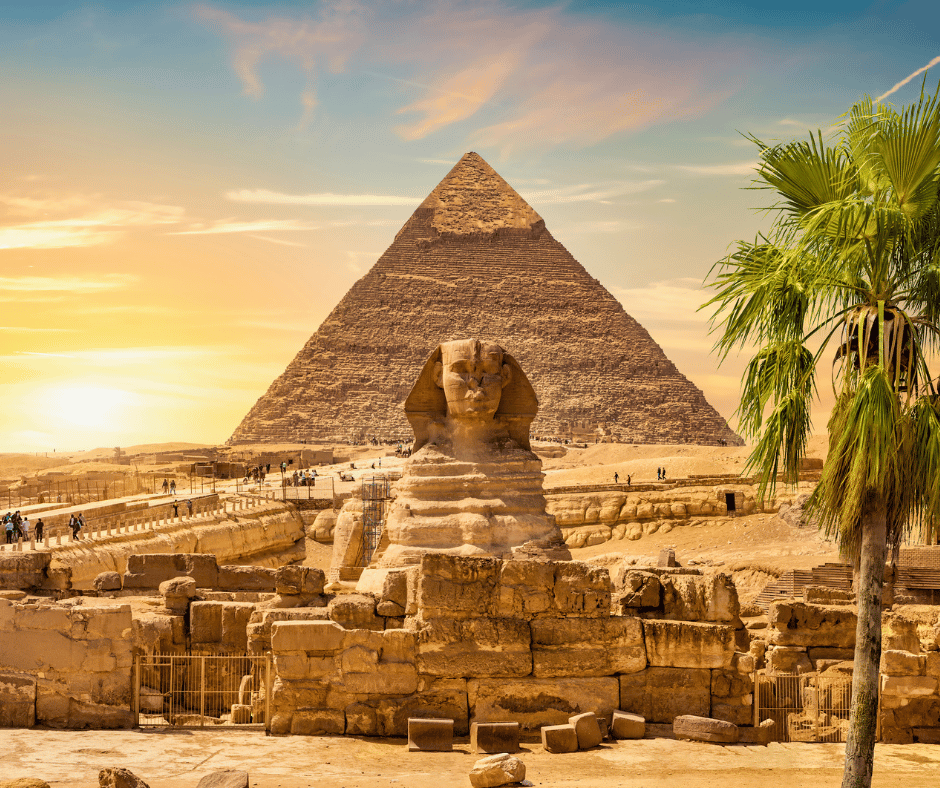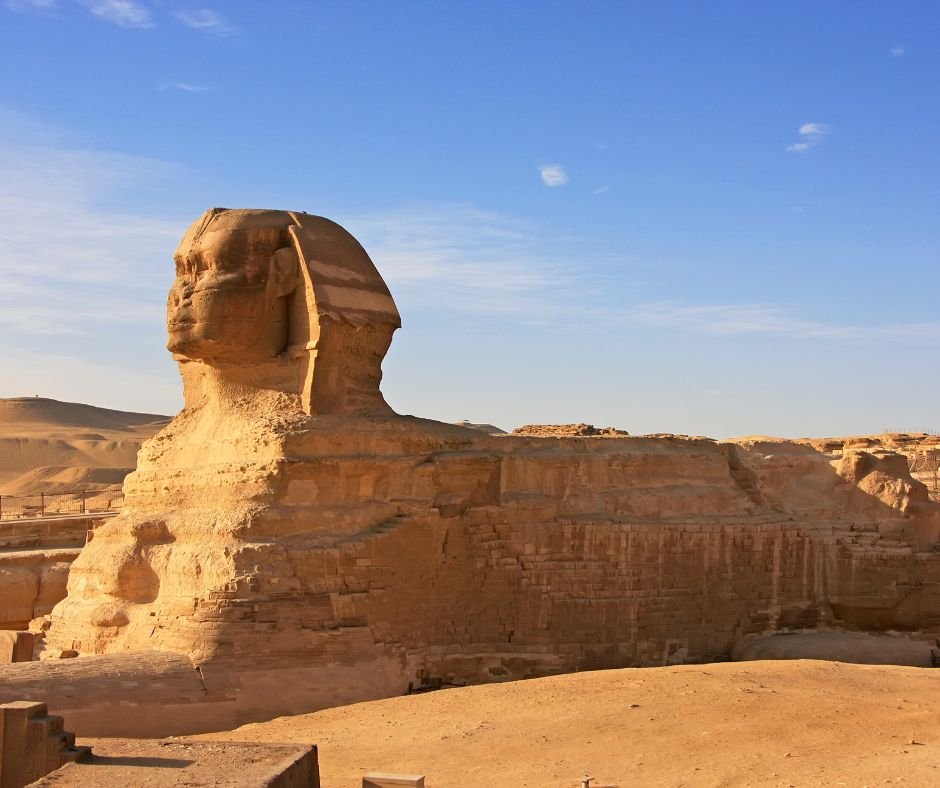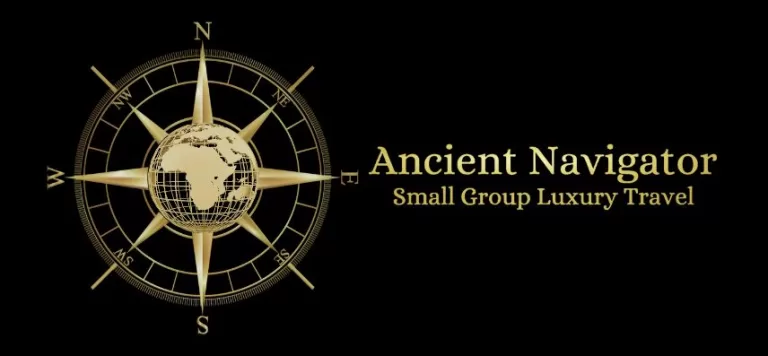Why You Must Visit the Sphinx: Egypt’s Timeless Wonder
Table of Contents
TL;DR Version: The Sphinx, one of Egypt’s most iconic landmarks, is a must-see for any traveler. With its rich history, captivating architecture, and spiritual significance, the Sphinx offers an unforgettable experience that connects visitors to the ancient world. This blog explores why the Sphinx should be at the top of your list when visiting Egypt, covering its historical importance, architectural marvels, spiritual significance, and more. Whether you’re a history buff, an adventurer, or a culture seeker, the Sphinx promises to leave you in awe.
Imagine standing before one of the most awe-inspiring monuments ever constructed—its immense, stoic presence silently watching over the centuries. The Sphinx of Giza, with its lion’s body and human head, is more than just a stone statue. It’s a symbol of ancient power, mystery, and wisdom that has captivated people for over 4,500 years. But why should you visit it? What makes this ancient monument one of the most sought-after destinations in the world? In this post, we’ll uncover the reasons the Sphinx isn’t just a historical relic—it’s a once-in-a-lifetime experience.
Key Takeaways
The Sphinx is one of the oldest and most enduring symbols of ancient Egypt.
Its architectural and engineering feats are still a mystery today.
Visiting the Sphinx connects you with millennia of history, mythology, and culture.
You’ll experience breathtaking views and learn about ancient Egyptian beliefs, arts, and spirituality.
The Sphinx, along with the nearby pyramids, offers an unparalleled glimpse into Egypt’s grandeur.

Historical Significance: A Monument of Timeless Legacy
The Sphinx stands as a living testament to ancient Egypt’s grandeur. Built during the reign of Pharaoh Khafre (around 2500 BCE), this massive statue is believed to represent the pharaoh himself—his face carved in stone to embody divine wisdom and power. But beyond its physical form, the Sphinx encapsulates the essence of Egypt’s ancient civilization.
Pharaoh’s Guardian: The Sphinx was constructed as a guardian to the nearby pyramids, ensuring the safety of the pharaoh’s tomb and legacy. Its role as a sentinel for the afterlife was deeply tied to Egyptian beliefs about life, death, and rebirth.
The Mystery of Its Origins: While historians agree on its age and purpose, the exact origins and the complete story behind the Sphinx’s creation remain a mystery. Some believe the Sphinx predates the Pyramid of Giza, adding another layer of intrigue to its already mystifying presence.
Deeper Insight:
The Sphinx isn’t just an architectural feat; it’s also an enigma. Throughout history, scholars and explorers have attempted to decipher the true meaning behind its form, its symbolism, and its purpose. From the riddle of the Sphinx in Greek mythology to modern-day speculations about its creators, the mystery continues to draw intrigue. Visiting the Sphinx allows you to witness this ongoing conversation between the past and present, inviting you to contribute your own interpretation.
Architectural Wonders: A Marvel of Ancient Engineering
At 66 feet tall and 240 feet long, the Sphinx is a staggering display of ancient architectural brilliance. Its sheer size and precision construction stand as a reminder of the engineering prowess of ancient Egyptians.
Construction Techniques: Made from limestone, the Sphinx’s massive form was carved directly from the bedrock of the Giza Plateau. This incredible feat of engineering was accomplished using rudimentary tools, yet the precision and artistry involved in its creation still baffles modern experts.
The Face of Khafre: The human face on the Sphinx is often thought to represent Pharaoh Khafre, the ruler for whom the nearby pyramid was built. The smoothness and symmetry of the face suggest a level of artistry that defies the tools available at the time.
Deeper Insight:
One of the most fascinating aspects of the Sphinx is how it’s weathered the test of time. Erosion has worn down its features over millennia, yet it still manages to convey a sense of grandeur and mystique. The Sphinx’s resilience speaks not only to the quality of its construction but also to the enduring legacy of the civilization that created it.
Spiritual and Mystical Significance: A Symbol of Power and Protection
In ancient Egyptian culture, the Sphinx was more than just a monumental sculpture; it was imbued with deep spiritual meaning.
Guardians of the Afterlife: The Sphinx, with its lion’s body and human head, symbolized strength, wisdom, and protection. Lions were seen as protectors in Egyptian mythology, while the human head represented intelligence and the divine connection between gods and pharaohs.
Legends and Myths: The Sphinx has also been the subject of countless legends, including the famous Greek myth of the Sphinx and Oedipus. In this myth, the Sphinx challenges travelers with a riddle, devouring those who cannot answer. This tale represents the idea of knowledge as a path to salvation and immortality.
Deeper Insight:
Modern-day visitors often find themselves drawn to the spiritual significance of the Sphinx, whether through its symbolic connection to ancient Egyptian gods or the powerful aura it exudes. The Sphinx’s presence, standing tall against the backdrop of the desert and the pyramids, creates a sense of awe and reverence that transcends time and culture.
The Sphinx as a Cultural Icon: A Timeless Representation of Egypt
The Sphinx is more than just a piece of history; it is an enduring symbol of Egypt itself. Whether you’ve seen it in textbooks, documentaries, or Hollywood films, the Sphinx remains one of the most recognizable symbols of ancient Egypt.
Global Recognition: From Indiana Jones to the pages of National Geographic, the Sphinx has captured the imagination of people worldwide. Its appearance in countless works of art, literature, and film has solidified its status as a cultural icon.
Cultural Influence: The Sphinx has influenced various cultures and religions over the centuries. Its symbolism has been adopted and adapted in art, architecture, and even modern spirituality, cementing its place in global culture.
Deeper Insight:
For travelers, the Sphinx offers more than a historical visit—it’s a chance to connect with a symbol that has transcended time and geography. It’s not just an Egyptian artifact; it’s a piece of global heritage, bridging the ancient world with the modern one.

Visitor Experience: What to Expect on Your Trip to the Sphinx
When visiting the Sphinx, you’re not just seeing a monument—you’re immersing yourself in history, culture, and adventure.
Nearby Attractions: The Sphinx is part of the Giza Plateau, which is home to the Great Pyramids of Giza and other ancient wonders. You can also explore the nearby Solar Boat Museum, which houses the famous wooden boat believed to have been used for the pharaoh’s journey to the afterlife.
Things to Do: Visitors can take guided tours to learn about the history and significance of the Sphinx, or ride camels to get a closer look at the monument and the surrounding desert. There are also various souvenir shops where you can purchase memorabilia from your visit.
Deeper Insight:
While many tourists are content with simply viewing the Sphinx from a distance, a more immersive experience can be found through guided tours. These tours often offer unique perspectives on the monument’s history and mythology, allowing you to understand its true significance beyond its impressive facade.
Conclusion: Why the Sphinx is a Must-See Destination
The Sphinx isn’t just another tourist attraction—it’s a profound connection to the ancient world, a living symbol of Egypt’s power, wisdom, and mystery. From its unparalleled history to its architectural genius, spiritual depth, and cultural significance, visiting the Sphinx is an experience unlike any other.
Are you ready to explore the wonders of Egypt?
Let Ancient Navigator guide you on a luxurious journey to the Sphinx and beyond. Book your trip today and witness firsthand the awe-inspiring beauty of one of the world’s greatest monuments.
Join our Email List
About the Author

James
A passionate traveler and writer who loves exploring the world, discovering new places, savoring unique foods, and connecting with fascinating people. Through their writings, James shares personal experiences and stories from every corner of the globe, with the hope that others can one day embark on these adventures for themselves. Whether it's about a hidden gem of a destination or a culinary delight, James's goal is to inspire and spark a sense of wanderlust in their readers.

James
A passionate traveler and writer who loves exploring the world, discovering new places, savoring unique foods, and connecting with fascinating people. Through their writings, James shares personal experiences and stories from every corner of the globe, with the hope that others can one day embark on these adventures for themselves. Whether it's about a hidden gem of a destination or a culinary delight, James's goal is to inspire and spark a sense of wanderlust in their readers.

















